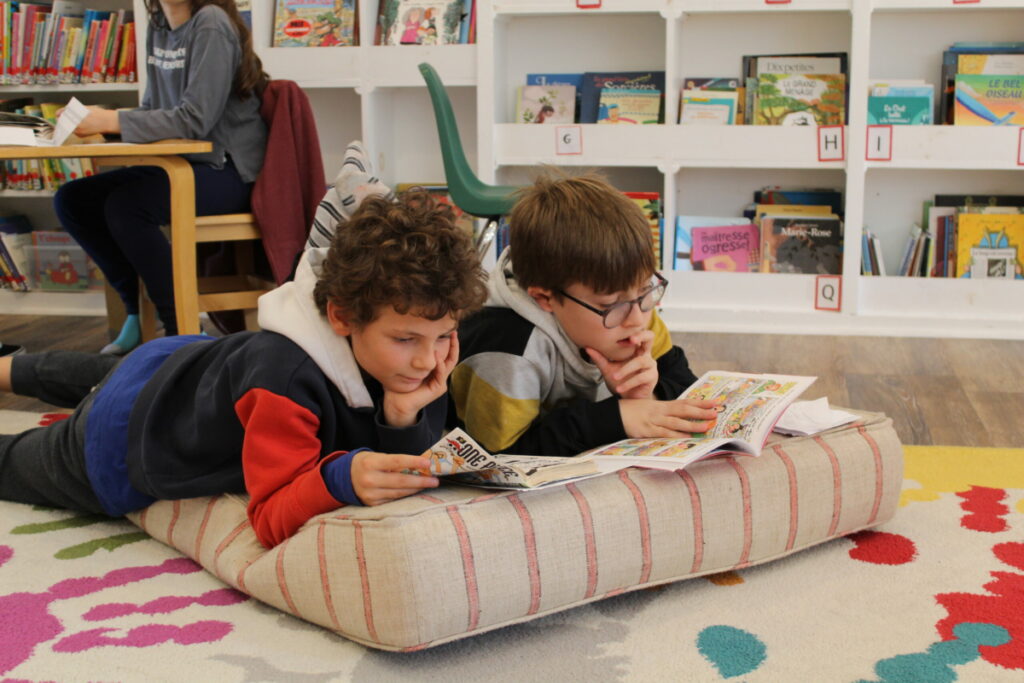Author: Lola Gueguen
Estimated reading time: 8 minutes
The first round of evaluations can feel daunting for both students and families. As parents, you may find yourself wondering: What exactly are these evaluations? How should I interpret the results? What do they mean for my child? It’s natural to feel uncertain when you first receive your child’s scores. The purpose of these early evaluations is to help teachers and parents better understand each child’s strengths, identify areas for growth, and tailor instruction to meet their individual needs. On a broader level, these results also help us understand how our students compare to other schools in the area as well as national benchmarks, guiding how we design curriculum and refine teaching practices. Most importantly, these assessments offer just one look into your child’s learning, and they are not a comprehensive picture of everything your child can do.
Table of contents
What Are These Evaluations?

At the FAA, students are administered two formative assessments:
- The MAP Assessment (Measures of Academic Progress) is a computer-adaptive test in English designed to measure student achievement and growth in reading, math, and language over time. Students take the assessment twice a year, once at the beginning and again in May or June. Teachers use the results to understand each student’s individual learning profile, set personalized goals, and tailor classroom instruction. The data also provides insight into what your child already knows and what they are ready to learn next, based on grade-level expectations and standards.
- Les évaluations nationales (the French National Exams) are standardized assessments used across France to evaluate a child’s progress in French, including reading, writing, vocabulary, and oral comprehension, as well as in math. At the FAA, students take these evaluations at the beginning of each grade.
How We Analyze and Use Assessment Results
As parents, it’s completely normal to feel unsure when reviewing your child’s assessment results. You may even feel worried or discouraged, especially if scores appear below grade level. However, these French and English assessments are not meant to overwhelm. They are valuable tools that help us understand each child’s unique learning profile.
MAP Assessments (Measures of Academic Progress):
The MAP Growth assessment helps us screen all students and understand how they are performing in reading, math, and language compared to peers in the same grade across the nation. It measures both achievement and growth. Achievement refers to how well your child has learned specific skills compared to students of the same grade level nationwide, while growth shows your child’s individual progress over time. Achievement is shown as a percentile, and MAP Growth scores are reported on the RIT scale (ranging from 100–350). The RIT score is an overall score for a subject based on the Rasch unit (RIT scale) and allows us to track a student’s growth both within a single year and from year to year. The FAA also compares results to other private schools in the NY and NJ area, where achievement norms tend to be higher than the national average.
The MAP Reading Fluency assessment focuses on foundational reading skills, including phonological awareness, phonics, word recognition, and comprehension, as well as oral reading fluency. Each student receives a score for each reading skill, as well as their oral reading rate (words read correctly per minute). This assessment helps identify the specific areas where students may be excelling and where they may need additional support. It also screens students who may be at risk for reading difficulties like dyslexia or language disorders. The dyslexia screener is given at the end of Kindergarten and, for new students, again in 1st grade. The report clearly flags students who may be at risk and shows how their results compare to grade-level expectations.
Les Évaluations Nationales:
These assessments, developed by the Ministère de l’Éducation Nationale in France, measure students’ skills in French and math starting in first grade. Students at the FAA take the same evaluation as the students in France do. The goal is similar to the MAP assessment: to show how students compare to grade-level standards and to other French-speaking students. FAA students’ results are compared to 65 schools in the North American zone, providing valuable insight into their academic performance and progress in a bilingual setting.
A Few Important Reminders:
- These assessments are NOT diagnostic tools. While these evaluations can screen or identify students who may be at risk, they cannot diagnose a specific learning disability or determine the exact cause of a student’s difficulties. Instead, they help us identify patterns and determine whether a child might benefit from additional support or individualized instruction.
- Assessments like MAP or the national French evaluations are not holistic measures of your child’s ability or potential. Factors such as motivation, attention, or test anxiety can all affect performance. At the FAA, we view these results as one piece of the puzzle that helps guide teaching and learning, not as a measure of your child’s future success.
Turning Results into Action
Once we receive students’ results, we immediately identify those performing below grade level and put a plan in place to help each child thrive and reach their full potential. This may include personalized strategies or learning plans for individual students, or, on a broader level, adjustments to teaching methods and general instruction. These assessments offer more than just insight into a student’s performance, they also provide an opportunity for teachers to reflect on and refine their own practices and curriculum implementation.
Students who score below average at the start of the year may also retake it in January to closely monitor progress and ensure supports are effective. Based on the results of both the English and French evaluations, students may receive the following types of support or remediation:
- Push-in or pull-out academic support
- Small-group instruction in targeted areas
- Additional FSL/ESL Support
- Classroom differentiation, accommodations, and modifications
- Personalized intervention plans (PPRE/PAP)
- Opportunities for grade advancement or more challenging work for advanced learns
In partnership with teachers, families play an equally important role in supporting students after evaluations. First and foremost, your role is to support and encourage your child, regardless of whether they achieved a perfect or above-average score. Your reaction to your child’s performance has a powerful influence on their self-esteem and motivation moving forward. Before focusing on any mistakes, take a moment to acknowledge their effort and hard work, and highlight the positives. These assessments also provide an opportunity for parents to engage in their child’s learning and actively support their strengths and areas for growth. For example, if your child is performing slightly below grade-level benchmarks in reading, you can use this as an opportunity to read together more at home. If they need extra support in math, try incorporating daily problem-solving into your routine. For instance, you might ask, “If we have two eggs but the recipe calls for four, how many more do we need?” If your child is excelling in a subject, enrolling them in an after-school activity can be a great way to further develop their skills and interests. At the FAA, we work closely with families to identify the supports needed, both inside and outside of school, to help every student succeed.
Helping Students Develop a Growth Mindset
At the FAA, we also remind students and families that these evaluations do not define a child or capture the full picture of who they are. The results are not labels, rather they are tools for learning and growth. Students have interests and strengths far beyond academics, including social-emotional skills, creativity, curiosity, and empathy, which these assessments do not measure. What we value and prioritize most is progress: how students use what they learn from these results to grow, and how teachers and families support them along the way. Mistakes and challenges are a normal part of the learning process; they help us reflect, adapt, and improve.

At the FAA, we emphasize six essential 21st century skills for lifelong success, called the 6 Cs: Character, Citizenship, Collaboration, Communication, Creativity, and Critical Thinking. When students show character, we believe they demonstrate perseverance, independence, compassion, and a growth mindset. Growth mindset is the belief that intelligence and ability can expand and develop through effort, perseverance, and learning. In contrast, a fixed mindset is the belief that intelligence and abilities are set and unchangeable, which can lead to negative self-talk, discouragement, and a tendency to give up when faced with challenges. Research shows that a growth mindset, however, is linked to many positive outcomes, like stronger coping skills (especially for anxiety, frustration, and disappointment), greater resilience, higher motivation, and lower levels of stress. Moreover, studies have found that students with a growth mindset tend to perform better academically (Dweck et al., 2017) (Tao et al., 2022). Ultimately, these evaluations are an opportunity to practice that growth mindset. It allows us to view results not as limits, but as a guide to recognizing strengths, identifying specific areas for improvement, and using that insight to grow.
Here are some ways you can support your child at home through the evaluation process while encouraging a growth mindset:
- Collaborate with teachers to reinforce positive learning habits at home
- Celebrate small successes and progress
- Praise the process and effort, not just the outcome
- Model reflection and a growth mindset yourself
- Using language that emphasizes growth, like adding “yet” to statements (e.g. “I don’t know yet how to divide”)
- Celebrate mistakes and embrace them as opportunities to learn
- Encourage positive self-talk (“You’re learning!”) and avoid negative self-talk (“You’re good/bad at this!”)
Evaluations are just one part of your child’s broader educational story. They help us guide and support each student’s growth, both academically and emotionally. With a shared focus on progress and perseverance, we can help every child reach their full potential!








